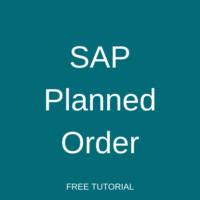 SAP Planned Order is an important component in the production and planning module in SAP. The planned order is considered as a procurement proposal in SAP. This means it is an intermediate state of a demand or procurement request.
SAP Planned Order is an important component in the production and planning module in SAP. The planned order is considered as a procurement proposal in SAP. This means it is an intermediate state of a demand or procurement request.
When production demand is entered in SAP, material requirement planning (MRP) is run. The result of MRP is the procurement proposals. For materials that are produced internally, MRP creates planned orders and for materials that are procured from external sources, MRP creates purchasing requisitions.
As mentioned above, MRP created planned orders for components based on the procurement type maintained in the material master. There are four procurement types in SAP.
- E – Inhouse production
- F – External procurement
- X – Both procurement types
- No procurement
For materials that are indicated as E or X in the material master, MRP creates planned orders. Materials that are indicated as “X”, can be produced in-house, or can be procured externally.
SAP Planned Order Creation
SAP Planned Orders can be created, changed, and displayed from the transaction codes MD11, MD12, and MD13. SAP has the option of creating a planned order manually. For that, we can use the transaction code MD11. Below are the contents of a planned order:
- Planned order number – This is a unique number that is allocated for the planned order, and it is used to identify the planned order. This number will be determined from a number range that is defined in the configuration. When the planned order number range is depleted, MRP will not create new planned orders. We can define a number range for manually created planned orders separately.
- Order quantity – Based on the production demand, SAP creates a planned order, and the order quantity will be based on the production demand. Based on the material master parameters, production demand can be split among multiple planned orders.
- Basic dates – Basic production start and end dates will be determined by the system based on the MRP parameters.
- Production plant – The plant in which the planned order is created.
- Production version – This is the production version that has been picked for the planned order. This is important because the bill of material (BOM) will be picked for the planned order based on the version.
- Planned order firming indicator – Based on the MRP parameters, the planned order number will change when MRP is executed. If we want to prevent MRP from changing the planned order, we can firm the planned order by selecting this indicator.
- Component overview – This shows the components in the planned order. This is based on the bill of material. The production version determines which BOM is applied for the planned order.
- Sales order – If the planned order is created for a make-to-order scenario where a sales order creates demand in the system, the relevant sales order number will be available in the planned order.
SAP Planned Order Conversion
The SAP Planned Order can be converted into production orders or purchase requisitions based on the requirement. If a planned order is converted into a production order, the content of the planned order will be copied to the production order.
Transaction code MD16 can be used to view planned orders created for a material.
—
Did you like this tutorial? Have any questions or comments? We would love to hear your feedback in the comments section below. It’d be a big help for us, and hopefully, it’s something we can address for you in the improvement of our free SAP PP tutorials.
Navigation Links
Go to the next lesson: SAP Batch Determination
Go to the previous lesson: SAP Production Order
Go to overview of the course: SAP PP Training
